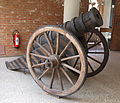Wooden cannon
A wooden cannon is a makeshift, primitive form of cannon . In addition to actually functioning wooden guns, dummy cannons were also made from wood, which were used either to mislead the enemy or as training weapons.
Wooden cannons as weapons of war
The nature of a wooden cannon is mentioned in the work of Vannoccio Biringuccio . This variant consisted of two pieces of walnut wood joined together, was lined with iron and surrounded by iron hoops. According to a Wittenberg Chronicle from 1730, a wooden cannon is said to have been removed from the rebellious peasants who besieged Archbishop Matthäus Lang von Wellenburg in Salzburg in 1525. In a sub-museum of the Salzburg Museum Carolino Augusteum , a specimen can be found that is said to have survived from one of the Austrian peasant wars . During the French Revolutionary Wars, the royalist Armée de Condé captured wooden cannons from the Republicans when they captured the Famars camp on May 23, 1793, for which a relatively detailed description of their construction and durability has been preserved:
“Their arrangement was as follows: In the trunk, which had been drilled according to the caliber, a can was inserted which held the powder charge and was made of cast iron and contained an ignition hole. This rested on a wedge, which was driven in as required, so that the rifle sat firmly and did not hit back, and the ignition hole could also be tuned again. An ignition hole was drilled through the wood up to the ignition hole of the iron gun. Some were also wrapped in rope and made more durable by some iron hoops. The cartouche fit into the iron box, and the bullet, grapeshot, or chopped iron came in front of it. According to the tests made with it, this tube withstood about 20 rounds without significant destruction. The army was followed by drills and rifles on wagons. "
A wooden cannon, which was probably used by Tyrolean farmers around 1809, is in the Germanic National Museum in Nuremberg.
In Japan around 1590, wooden cannons were used to fire paper incendiary projectiles containing oil and powder into wooden castles to set them alight. In Japanese Aizu a wooden cannon is Edo period issued. It was probably loaded with coarse shotgun pellets and used against infantry. Wooden guns were used in Asia until the second half of the 19th century.
The Musée de l'Armée in Paris houses a wooden cannon from Vietnam . It consists of two hollowed-out halves and is held together by metal rings. The soul (hole) is apparently lined with metal. It is not certain, however, whether the cannon could withstand repeated firing.
Wooden cannons as dummies

The function of dummies was either to deceive the enemy about one's own military strength or as an aid to training one's own troops. The ruse of using wooden dummy cannons to deceive the enemy is quite old. During the siege of Boulogne in 1544, the English are said to have positioned large wooden cannons which even gave the impression that they could actually fire because a metal tube was attached to them, which fired the actual "shot". Not only besiegers but also defenders used dummy cannons. An example from the American Civil War is the equipping of the defenses around Centerville, Virginia, with so-called "Quaker Guns" by the Confederates in 1862. While the impression was to be created that the works were still occupied, the Confederates actually withdrew. This type of deception was also used in seafaring. On the sides of merchant ships of the 18th and 19th centuries, dummy cannons were occasionally attached to the pirate ships to simulate a stronger armament than was actually available. The same purpose was pursued with false gun ports . In the case of aircraft, the machine guns were sometimes replaced by wooden dummies in order to save weight. B. in the Doolittle Raid 1942.
In contrast to the above examples of war lists, dummy guns made for training purposes are intended to replace the lack of real weapons in training. For example, since the Reichswehr was prohibited from possessing many modern weapons due to the provisions of the Versailles Treaty in the 1920s and early 1930s, training took place on dummies.
Individual evidence
- ↑ Reproduced in Demmin, August: The historical development of the weapons of war from the oldest times to the present, Leipzig 1893, p. 108.
- ↑ This rather vague information is also in Demmin, p. 109. See also the web link to a picture of the farmer's guide Mathias Stöckl.
- ↑ Blesson, Louis (actually Johann Ludwig Urbain): History of the siege war or the offensive fortifications. A sketch. Berlin 1835, p. 158 f. According to Blesson, the description comes from a Colonel Lancry. [1]
- ↑ The art and cultural history collections of the Germanisches Museum. Guide for visitors, Nuremberg 1904, p. 133.
- ^ Kure, Mitsuo: Samurai - Bushido - Der Weg des Kriegers, Weltbild 2006, ISBN 3-8289-0585-4 , page 182.
- ^ Carman, WY: A History of Firearms: From Earliest Times to 1914, Courier Dover Publications, 2004, ISBN 978-0-486-43390-5 , 64.
- ^ Carman, p. 64
- ^ Bobrik, Eduard, General Nautical Dictionary, Leipzig 1850, p. 371.
swell
- Blesson, Louis: History of the Siege War or Offensive Fortifications. A sketch. Berlin 1835.
- Carman, WY: A History of Firearms: From Earliest Times to 1914. Courier Dover Publications, 2004, ISBN 978-0-486-43390-5 , [2]
- Demmin, August: The weapons of war in their historical developments from the oldest times to the present. Leipzig 1893.
- Kure, Mitsuo: Samurai - Bushido - The way of the warrior. Weltbild 2006, ISBN 3-8289-0585-4 .




